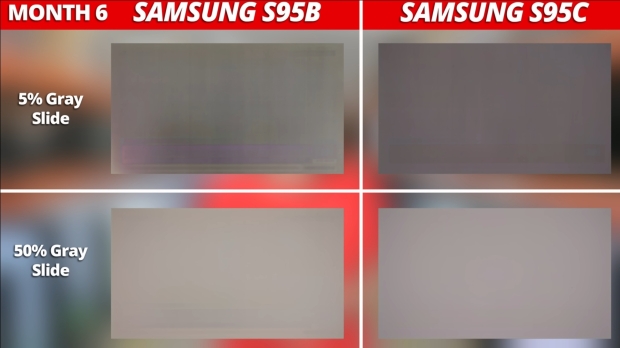OLED displays for 4K TVs and PC gaming monitors are some of the best options for image quality and responsiveness - to the point where no other panel technology comes close. OLED technology, which uses organic material that degrades over time, is prone to that one thing people worry about when shelling out for the latest and greatest display tech - burn-in.

The issue of OLED burn-in is improving gen-to-gen, image credit: RTINGS.
Burn-in is effectively permanent image retention that can destroy immersion when viewing content or playing games. Even though the headline to this article might sound like it's still a major problem for OLED displays and that you should look at alternatives, the extensive testing carried out by the display gurus over at RTINGS.com - is mostly good news for how far OLED technology has come.
There's evidence of burn-in and temporary image retention, but standard LCD panels fared worse with "severe uniformity issues." Still, we're talking about an intense, over-the-top test that displayed a graphic and logo-heavy CNN image on each OLED display at maximum brightness. Then, it was left on for 6,000 hours or over 4 years of real-world usage.
Some gaming monitors tested include the Dell Alienware AW3423DWF, LG 27GR95QE-B, and the Samsung Odyssey OLED G8 (testing here has only been going for six months), alongside multiple generations of LG OLED TVs and other models from Samsung and Sony. For the PC gaming monitors, there is "very little image retention" after six months of the intense test - to the point where it's not noticeable with regular usage.

Newer LG OLED TVs showcase dramatic improvements regarding the burn-in problem, image credit: RTINGS.
However, first-generation QD-OLED technology with super-bright panels can lead to faster degradation than WOLED technology. OLED gaming displays have come a long way and feature technology to minimize heat, like those found in new ASUS OLEDs.
Interestingly, the tests resulted in more displays failing than severe cases of burn-in or image retention in new panels with LCD panel uniformity (brightness looking the same across the entire panel) showing weird "zebra" patterns across different brands and models. Often, the results here are worse than an OLED burn-in.
Regarding OLED TVs, newer models perform better than older displays, like the LG CX OLED and the Sony A8H, which showcase obvious burn-in problems. You could say that the LG C2 OLED's burn-in is minimal and non-intrusive.
You can watch the full presentation of RTINGS findings below.



